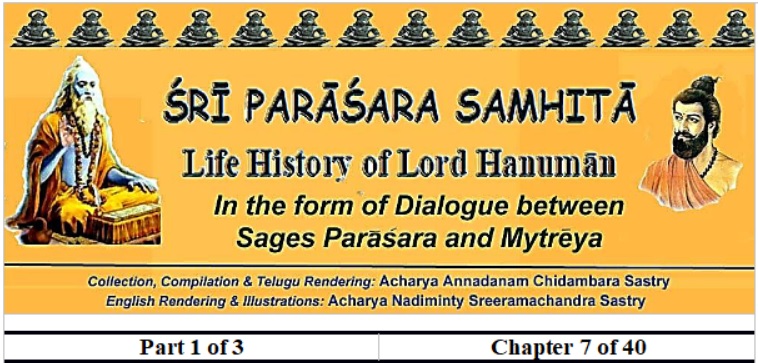
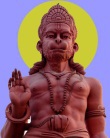
7th Chapter (Saptamah Paţalah)
Story of Suvarchalāhanumat Dwādaśākşara Mantra
(Suvarchalāhanamaddwādaśākşaramantrakathanam)
श्री मैत्रेय:
Mytrēya:
आंजनेयस्वरूपं तस्योत्पत्तिर्मन्त्रवैभव
कथितानि त्वया ब्रह्मन् श्रुतनीह मया प्रभो।। 1
“Oh! Capable sage Parāśara! I heard the birth, form and greatness of Hanumān mantra described by you.
सुवर्चलासमेतश्रीहनुमद्द्वादशाक्षर:
कीद्शस्तत्पुरश्चर्या तस्योत्पत्तिश्च कीदृशी?
पुरा के वा पुरशचर्यां कृत्वा सिद्धिमवाप्नुवन्?
श्रोतुमिच्छामि तत्सर्वं वण्र्यतां भगवन्! मुने! 2
Oh! Great soul! What is the nature of the Suvarcchala—Hanumān12_lettered (dwādasākşara) mantra? How is it recited systematically? (puraścharya = recitation of the Holy Name 100,000 or in its multiples of EACH syllable wise – not each letter wise); How was that mantra born”
श्रीपराशर:
Parāśara:
सप्तकोटिमहामन्त्रा: प्रोक्ता गौर्यै हि शम्भुना
शैवाश्च वैष्णवास्सौरा: गाणपत्या: शिवात्मिका:।। 3
I would like to know whether aby one undertook that puraścharya and attained fulfillment. Kindly let me know.
कौमारा भैरवाश्चान्ये केचिन्मंत्रा हनूमत:
केचिद्भुक्तिं प्रचुर्यन्ति केचिन्मुक्तिं दिशंति च।। 4
Mytrēya! 70 million mantras were told by Paramēśwara to Pārvatīdēvi. Some of them give relief in this material World, while others allow attainment into the World beyond. Some of them are related to Śiva, some to Vishnu, some to Sun, some to Gaņeśa the elephant headed God (younger son of Śiva), some others to Gaurī, some to Kumāra (elder son of Śiva – Kārtikēya) and some to Bhairava (a form of Śiva). Some others are related to Hanumān.
देवतानां यथा विष्णु: नक्षत्राणां यथा शशी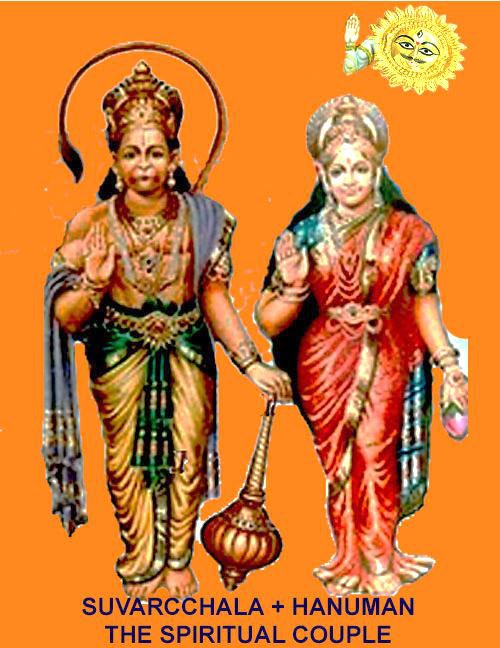
ग्रहाणां तु सहश्रांशु: नदीनां जाह्नवी यथा
तथा सुवर्चलायुक्तहनुमद्द्वादशाक्षर:
मंत्र: श्रेष्ठतरश्शीघ्रं भुक्तिं मुंक्तिं प्रयच्छति।। 5
Like Vişņu among Gods, Moon among the stars, Sun among the planets, Gangā among the rivers are great, the 12_lettered (Hanumaddwādasākşara) mantra bestows the very best nourishment (bhukti) and liberation (mukti).
न कालदेशनियमो नारिमित्रादिशोधनम्
प्रसन्नोपासकगुरोर्मुखाल्लब्ध्वा मनुं त्विमम्।। 6
There is no restriction for recitation of this mantra of a particular time or place or person. Taking initiation (upadēśa) from a pleasant practicing Guru
गुरुं संतोषयेद्धीमान् शुश्रूषास्वर्णभूषणै:
वस्त्रैर्माल्यैर्धूपदीपैरभीष्टै: मिष्टभोजनै:।। 7
The interested wise person should serve the Guru and satisfy him with golden ornaments, clothes, garlands, incense, lamps, liked food and others.
गुरोस्संतोषणेनैव हनुमान् भक्तवत्सल:
संतुष्य सकलाभीष्टान् ददातीह न संशय:।। 8
If the Guru is happy devotee-surrendering Hanumān will be happy and fulfills all sought desires. There is no doubt about it.
अत्याशमतिलुब्धं च दांभिकं ज्ञानवर्जितम्
असंतुष्टमशांतं च न पापं गुरुमाश्रयेत्।। 9
A person seeking too much, miserly, showing off, unwise, unsatisfied, peace less or evil doer should not go to approach a Guru.
नास्तिकाय कृतघ्नाय वंचकायातिलोभिने
अनाचाराय पापाय नैतन्मंत्रं प्रदापयेत्।। 10
To one who does not accept Vedas as he standard, forgets the good turn done to him, a deceiver, non-follower of tradition, sinful this mantra should not be imparted.
जगत्प्राणतनूजत्वात् जगत:प्राण एव स:
तदधीनं जगत्सर्वमिति मे निश्चिता मति:।। 11
Like air is the very life of the world, air-wind God Vāyu’s son Hanumān is also life to the world. My firm opinion is that the whole universe is under His control.
आदौ प्रणवमुच्चार्य श्रीबीजं तदनन्तरम्
तत: श्रीवर्णमुच्चार्य सुवर्चलापदं तथा।। 12
Suvarchalāhanamaddwādaśākşaramantra
First utter the cosmic resonance sound ‘Omm’, then the seed (bīja) word ‘Śrīmm’, then the letter ‘Śrī’, afterwards, ‘Suvarcchalā’ (and)
हनुमत्पदमुच्चार्य नमश्शब्दं तत: परम्
द्वादशाक्षरमंत्रो यं पुरश्चर्याविधिं तृणु।। 13
‘Hanuman’ and say the word ‘namah’: “Omm Śrīmm Śrī Suvarcchalā Hanuman namah,” is the Suvarchalāhanamaddwādaśākşaramantra. Now listen to the method of systematic recitation? (puraścharya).
अहमेव ऋषिस्तत्र गायत्री छंद एव वा
सुवर्चलासमेतश्श्रीहनुमान् देवता तथा।। 14
I, Parāśara, am the sage priest (ŗşi) for this mantra. The meter (chandas) Gāyatrī (The shortest and most sacred of Vedic meters; consists of three octosyllabic feet – pada, 3×8 – with 24 syllable) and the deity is Suvarchalāhanumān.
मारुतात्मजबीजं च शक्तिरत्रांजना सुत:
कीलकं वायुपुत्रस्तु मम श्रीपदमुच्चरेत्।। 15
Saying ‘son of Wind God (Mārutātmaja), the seed (beejam), son of Añjana (Añjanāsuta) is the power (śakti), son of Wind God’ (vāyuputah) is the key (keelakam)’ and then telling ‘my precious’ (mamaśrī)
NOTE: At the start of performing any worship or recitation (japa) or meditation we remember the Rsi (sage), Chandas (meter), Presiding deity (Devata), Beejam (the seed), Shakti (the power) and the Keelakam (key) of the given mantra.
सुवर्चलेशहनुमत्प्रसादे विनियोजनम्
अंगन्यासं करन्यासं कुर्याद्वै मूलमंत्रत:।। 16
Having said “Suvarchalēśa hanumatprasadē viniyōgah” (Lord of Suvarchala, Hanumān gifted, submitted to), one has to perform añganyāsa (touching body parts) and karanyāsa (hand positioning), reciting the basic (mūla) mantra.
अंजनासुतायेति च ततो वै रुद्रमूर्तये
वायुसुतायेति तथाग्निगर्भाय तत: परम्
श्रीराममुख्यदूतश्च ब्रह्मास्त्रादिनिवारण:
भूर्भुवस्स्वरोमिति च दिग्बंधनपदं वदेत्।। 17
Saying sequentially and performing añganyāsa (touching body parts), “Añjanāsutāya, Rudramūrtayē, Vāyusutāya, Agnigarbhāya, Śrīrāma Mukhyadūtāya, Brahmāstradinivāraņāya, bhūrbhuvassuvarōmiti digbhandhah” = Son of Añjanā, soul of Rudra, son of Wind God, one held within Fire God, principal emissary of Lord Śrīrāma, one capable of stopping the Creator Missile (all indicating Lord Hanumān); in the bhoo, bhuvah) and suvah; then say digbhandhah.
NOTE: Before any worship (pooja) or recitation (japa) or_ fire ritual (homam), we do anga nyasa (touching body parts) and kara nyasa and then digbandha (locking self in). Phase 1 = invoking the particular deity); Phase 2 = Nyasas are supposed to ‘place’ the energy of certain sounds in specific chakras (energy centers) of the body alluding to bhoo (spiritual energy of the Earth/own body), bhuvah (trouble-freeing world of ancestors – pitŗlōka/soul) and suvah (happiness/life); Phase 3. Then digbandha is supposed to lock all directions so that no energy except that of the deity being worshipped can enter the area. You are placing an energy fence around you that can be crossed only by a specific energy.
ध्यानम्
सुवर्चलाधिष्ठितवामभागम्
वीरासनस्थकपिवृन्दसेव्यम्
स्वपादमूलशरणगतानाम्
अभीष्टदं श्रीहनुमंतमीले।। 18
Dhyānam:
I pray at the lotus feet of Lord Hanumān that bestows desired wishes of devotees and being served by the great monkey heroes sitting in valor posture (vīrāsana) on the left side of Suvarcchalādēvi,
भक्तकल्पतरुसौम्यं लोकोत्तरगुणाकरम्
सुवर्चलापतिं वन्दे मारुतिं वरदं सदा।। 19
I always bow to Māruti, husband of the most virtuous in the world Suvarcchala, that fulfills the wishes of devotees like the Wish-Fulfilling Tree (kalpavŗkşa) and gives boons.
पद्मासनं समास्थाय पूर्वाभिमुखतो नर:
प्रात:काल उपक्रम्य अपराहने जपेन्मनुम्।। 20
Method of performing the Ritual
The mantra has to be recited starting early in the morning sitting in lotus posture (padmāsana) facing the East, going till well after noon.
आंजनेय: पूजितश्चेत् पूजितास्सर्वदेवता:
हनुमन्महिमा शक्यो ब्रह्मणापि न वर्णितुम्।। 21
Worshipping Hanumān means like worshipping all the gods. Describing the greatness of Hanumān is impossible even to Brahma the creator.
सिंधुसंगममध्ये तु नदीतीरे विशेषत:
हनुमत्सन्निधौ वापि गृहमध्ये विशेषत:।। 22
The recitation (is done) at the confluence of rivers with the sea or on the bank of a river or in the house itself in fron of the Hanumān idol,
अश्वत्थतरुमूले तु पर्वताग्रे तथैव च
अयुतं तु पुरश्चर्यामिताहारो जितेंद्रिय:।। 23
Or sitting at the base of sacred fig tree (asvattha; Ficus religiosa) or on the top of a hill the 10,000 recitation have to be done systematically. During this period, the body sensory organs have to be controlled and only limited quantity of food has to be taken.
जपमध्ये·प्यधश्शायी हविष्यं भक्षयेत्तत:
प्रथमे हि यथाहार: आसमाप्ति तथैव च।। 24
During the period of recitation one has to sleep on the floor. Only the food items left over after fire sacrifice has to be eaten. The same regime of food intake has to be maintained on all the days till the last day.
दशांशं तर्पयेद्धीमान् तद्दशांशं हुनेत्तथा
पायसापूपदध्यन्नै: ब्राह्मणान् भोजयेत्तत:।। 25
One tenth of the time of recitation with libation with water (tarpaņa), one tenth with milk-rice pudding (pāyasa), fried rice cakes (appams) and curd-rice (dadhyōjana) have to fire sacrificed, afterwards feeding Brāhman people satisfactorily.
गोक्षीरशर्कराज्यैश्च तर्पणं तु समाचरेत्
मध्वाज्यशर्कराभिश्च अपूपैश्च हुनेत्तत:।। 26
Libation has to be done with cow milk and sugar, afterwards with honey, ghee, sugar and rice cakes in the fire sacrifice (hōmam).
खर्जूरकदलीभिश्च नारिकेलफलैस्तथा।।
मल्लिकाजातिपुष्पैश्च चंपकै: वकुलैस्तथा।।
हुनेदष्टोत्तरशतं कुबेरसदृशो भवेत्
सुरराजसमं लोके ऐश्वर्यं शाश्वतं ध्रुवम्।। 27
One performing fire sacrifice 108 times with date fruits, banana fruits, coconuts, jasmine, tuberose and other flowers wil become rich equal to the Lord of Wealth (Kubēra) and will come to possess unending prosperity like Dēvēndra.
हनुमत्कृपया नित्यं सर्वलोको वशे भवेत्
एतस्यैव जपेनेंद्रो वृत्रासुरमसूदयत्।। 28
Fruits of the Ritual
The whole world can be kept under control by the grace of Lord Hanumān; by the power of this mantra only Dēvēndra could kill demon Vŗtrāsura.
इमं जप्त्वा भीमसेनो जरासंधमसूदयत्
स्वांगविकारसिध्द्ध्ययर्थमेतद्ब्रह्मा जजाप ह।।
एनं विभीषणाल्लब्ध्वा ताक्ष्र्यो प्यमृतमाहरत्।। 29
After reciting this mantra only Bhīma could kill Jarāsandha. Creator Brahma recited this mantra for the success of his missile, Brahmāstra. Receiving this mantra from Vibhīşaņa, Garuda (great bird) could bring life giving Amrita (ambrosia).
गर्गाचार्यादिमं लब्ध्वा सीता सा जनकात्मजा
इषूनलीलया पूर्वं शताननमहासुरम्।।
एतन्मंत्रपुरश्चर्या कृता पूर्वं महात्मभि:।। 30
Imparted by sage Garga Janaka’s daughter Sītā could easily kill demon Śatakanţha.
शताननवधं सीता कथं कृतवती पुरा
रामे च लक्ष्मणे चैव शत्रुघ्ने भरते स्थिते।। 31
The systemic performance of this ritual was carried out by many great souls in the past.”
शताननवध:
Śatakanţhaŗavaņa Vadha
(Killing of the demon Śatakanţhaŗavaņa)
मैत्रेय:
हनूमत्यपि सुग्रीवे तत्सर्वं वण्र्यतां मुने
श्रोतुमिच्छाम्यहं ब्रह्मान् परं कौतूहलं हि मे।। 32
Mytrēya:
Oh! Sage Parāśara! When Rāma, Lakşmaņa, Bharata and Satrughna were there, how come Sītā had to kill Śatakanţha?
सीतायाश्चरितं वक्ष्ये कल्याणं तृणु तत्त्वत:
या लोकमाता श्रीविष्णो: वल्लभा जगदीश्वरी।। 33
There were Hanumān and Sugrīva too, is it not? Please tell me how Sītā had to kill? Oh! Great Sage! I am excited hear that part of the history.”
राम: कमलपत्राक्ष: सेतुं बद्ध्वा महोदधौ
सुग्रीवसचिव: श्रीमान् अवधीद्रावणं रणे।। 34
Parāśara:
I am describing the auspicious history of mother of the world, consort of Lord Vişņu, Goddess of the Universe, Sītā.
स्वात्मानं राघवो मेने कृतार्थं दैत्यनाशनात्
एतस्मिन्न्ंतरे वाणी अंतरिक्षे जगाद तं।। 35
Lotus-petal-eyed Rāma, built a bridge across the sea (Rāmasētu), with Sugrīva as His minister, killed Ŗavaņa in the war. When Rāma felt that He was successful in destroying the demons in the war, Voice from the Sky (Ākāśavāni) said so,
शतयोजनभूताब्धौ कियान् दशमुखासुर:
सहस्रयोजनाब्धौ तु गगने परिवर्तित:।। 36
Śatānana:
“What is this 10-headed Ŗavaņa about 100 yjan (around 1300 km) beyond the sea? Śrīrāma! Located 1000 yjan (around 13000 km) away, flying around in the sky, there is a very valorous 100-headed one.
अजेयस्सर्वभूतानां जहि तं दैववैरिणम्।। 37
He cannot be defeated by any living creature. So, destroy that enemy of the celestial beings.
तच्छ्रुत्वा राघवो धीमान् अभूच्चिंतापरायण:
शतयोजनविस्तीर्णं समुद्रे सेतुबंधनं
कृत्वा कष्टदशां घोरां संप्राप्ता वानरा इति।। 38
Hearing this, Śrīrāma thought, ‘The monkey forces are very tired after building the 1300 km bridge across the sea.
सहस्रयोजनांभोधौ सेतोश्च बंधनं यथा
अतीव दुस्तरं ह्रोतदिति चिंतां करोति स:।। 39
It is nay impossible to build a bridge of 13000 km’, so He thought.
तमुवाच महातेजा हनुमान् मारुतात्मज:।। 40
Hanumān to the Resque:
Then the mighty strong son of the Wind God Hanumān said to Him, so.
प्रसार्य लांगूलमहं सहस्रयोजनादति
अत्यंतकायसंयुक्त: तिष्ठामि वरुणालये।। 41
“I will extend my tail beyond 13000 km and will stay in the sea by expanding my body to a great size.
सप्तसागरपर्यन्तं वर्धयिष्यामि सेतुवत्
लांगूलेनांबुधिं तीत्र्वा जहि तं हि शताननम्।। 42
I will extend my tail like a bridge across the Seven Seas. Using my tail (bridge) go and kill that Śatānana.
इत्युक्त्वा दीर्घलागूलं प्रसार्य पवनात्मज:
मार्गं कृत्वा समुद्रांतमतिष्ठत्तत्र संस्थिते:।। 43
So saying, Hanumān (attaining great size, virātarūpa) stood in the sea, his tail extended as a bridge till the end of the sea.
लांगूलरोमजालेषु नक्षत्रााणि तथा ग्रहा:
दृश्यन्ते दर्भपुंजेषु यथैव हिमविंदव:।। 44
All the stars and planets spangled the switch of His tail, looking like frost drops sticking to a tuft of grass (darbha),
ततो दाशरथी श्रीमान्-चतुरंगबलैस्सह
गत्वा वानरसैन्यैश्च युद्धाय समुपस्थित:।। 45
Then Śrīrāma moved (on it) with the four-leg (infantry, cavalry, chariots and elephants) and the monkey forces and posotopned for war.
अन्तरिक्षपुरं तस्य ह्मगम्यं सर्वदेहिनाम्
अदृश्यमितरेषां तत् असाध्यं देवदानवै:।। 46
Śatānana’s is a flying city (antarikşapuri). It cannot be seen by any one; even to gods and demons it is impossible.
प्राकारो ग्निमयस्तस्या: अप्रधृष्य: पराक्रमै:
इत्याकाशवचश्श्रुत्वा राघवश्चिंतितो बहु।। 47
The encircling protective wall of that city is full of rearing flames. Hearing the Voice of the Sky saying, ‘It cannot be breached by valor,’ Śatānana thought a lot (about the solution).
तदा हनुमान् दुर्धर्ष: प्राकाराग्निसरित्पतौ
क्षिप्त्वा तत्पुरपर्यतं स्वलांगूलमवर्धयत्।। 48
Upon that Hanumān became very angry, threw the protective surrounding fire in the sea and extended his tail till the city.
तत्पुरीसमलांगूले चतुरंगबलैस्सह
भ्रातृभिस्साकमारुह चकार कथ्दनं महत्।। 49
Riding the extended tail of Hanumān, went to war along with his chariot, elephant, horses and cavalry forces and his brothers.
तद्युद्धमभवद्घोरं तुमुलं रोमहर्षणम्
शताननस्य रामस्य वानराणां च रक्षसाम्।। 50
War with Śatānana:
That war between Śrīrāma and Śatānana, between the celestials and the demons was ghostly, perplexing and hair-raising.
शिरांसि तस्य कृत्त्त्तेषु तीक्ष्णै राघवसायकै:
पुनरेव प्ररोहंति घोररूपशिरांसि वै।। 51
As soon as Śrīrāma’s sharp arrows cut off Śatānana’s heads, they same would crop up again in a eerie manner.
तस्य दैत्यस्य रक्तेन संसक्ता भुवि पांसव:
भवन्ति तत्क्षणादेव सर्व एव शतानना:।। 52
All the soil particles that got wet with Śatānana’s blood would turn into demon Śatānanas.
ते युध्यंति महावीरा महाबलपराक्रमा:
शताननानां सर्वेषां यावंतो रक्तबिंदव:।।
संसिक्ता भूपरागे स्युस्तावंतस्तु शतानना:।। 53
All of them became very strong and fought valorously. All the drops of all such relicated Śatānanas’ blood would turn into more demon Śatānanas again.
एवं शताननास्सर्वै राघवैस्सह संगता:
युध्यंतो मूर्छिताश्चक्रु: भ्रातृन्संग्राममूर्धनि।। 54
Thus all those Śatānanas. Fought ferociously with Śrīrāma and made Rāma, Lakşmaņa, Bharata and Satrughna faint.
मूर्छितान् राघवान् दृष्ट्वा सीता चिंताकुलाभवत्
एतस्मिन्नंतरे गर्ग: समागत्य महामुनि:
द्वादशार्णं मनुं तस्यै ददौ सीता जजाप च
तस्मात्प्रसन्नो हनुमान् अभवद्विश्वरूपधृत्।। 55
Mega Form of Hanumān
Seeing Rāma and others faint in that manner Sītā was saddened greatly. At that moment sage Garga came there and imparted (upadēśa) the dwādaśākşaramantra, which She started reciting. Greatly obliged, Hanumān rose to his mammoth form (viśvarūpa).
वानरं मुखमेकं तु द्वितीयं सिंहवक्त्रकम्
तृतीयं गारुड़वक्त्रं चतुर्थं सौकर मुखम्
हयाननं पंचमं चाप्येकैकं नयनैस्त्रिभि:
दशबाहुसमोपेतं दशायुधसमन्वितम्।। 56
That mammoth form had five faces – the first one is that of monkey, the second one that of the lion, the third one that of Garuda the eagle king, the fourth one that of the pig (the primal varāha),
तदाप्रभृति कथित: पंचास्यो हनुमानिति
रूपं तस्य बभौ यद्यत् रुद्रस्य पुरघातिन:।। 57
The fifth one that of horse (Hayagrīva – lord of wisdom) and each face having three eyes each, He wore ten weapons in ten hands.
शताननानां सर्वेषां यावंति वदनानि वै
तावंतो पंचवंदना बभूव कपिकुंजर:।। 58
From then onwards Hanumān is known as Pañcamukhahanumān. His form was shining like that of the face of Rudra (ferocious form of Śiva) at the time of killing demon Tripurāsura.
ततो हनुमान् स्वस्कन्धे चारोप्य जनकात्मजाम्।
भयमापादयामास राक्षसानां दुरात्मनाम्।। 59
He turned into as many number of Pañcamukhahanumāns as there were faces (heads) of all the Śatānanas.
ततस्सीता भगवती कालीरूपं दधौ दु्रतम्
भयंकरी बभूवाथ युयुधे शरवर्षिणी।। 60
Then He carried Mother Sītā on His shoulder and started frightening the evil demons.
तद्युद्धमभवद्घोरं सीताया रक्षसां तथा
रक्षोरक्तद्र्ररेणूत्थराक्षसान्वीक्ष्य विस्मित:।। 61
Sītā fights Śatānana
Right then, Mother of the World (lōkamāta = Sītā) took the form of Goddess Kāli and fought, raining terrifying arrows.
तस्थौ विस्तार्य लांगूलं हनुमान् रक्तपातने
अभावाद्रक्तपातस्य क्षितौ नष्टाश्शतानना:। 62
Terrifying was that war between Mother Sītā and the demons. Hanumān was surprised to see the demons rising relentlessly from the soil particles wet with blood.
सीतायाश्शरवखर्षेण चैक एवावशेषित:
ततस्सीता महाघोरं शरमग्निशिखोपमम्
संधाय धनुषि श्रेष्ठमिदमाह सुमध्यमा।। 63
The Hanumān grew his tail to cover the entire area as a result of which no more blood could fall on the ground. Since no blood fell on the ground (no new demons came up), the killed ones caused reduction in their number.
एकपत्नीव्रतो रामो यद्यहं पतिदेवता
पतत्वनेन बाणेन शताननशिरो महत्।। 64
Thanks to the rain of arrows by Sītā only the (real) Śatānana was left. Then Sītā set a fire belching arrow to Her bow and said so,
इत्युक्त्वा जानकी बाणात् पातयामास तच्छिर:।। 65
“If Lord Śrīrāma is dedicated to a single wife (ēkapatnīvrata) and if I always consider my husband as God (pratyakşadaiva) let this arrow cause fall of Śatānana’s head.”
पपात पुष्पवृष्टिश्च नेदुर्दुन्दुभयो दिवि
वानराश्च नराश्चैव स्ंतुष्टा स्स्कलाभवन् || 66
So saying Sītā released the arrow and cut off Śatānana’s head.
तेषां स्ंतोष घोषेण राघवास्सहसोत्थिता:
सीतां दृष्ट्वा हनूमंतं श्रीरामो वाक्यमब्रवीत्।। 67
The celestial beings rained flowers. Divine drums (dēvadundhubis) rattled, People, monkeys and others were very happy.
युवयोर्विश्वरूपं च मम दर्शयितुं क्षमम्
सीता च हनुमांश्चैव तदा श्रीराममूचतु:।। 68
Sītā Wins
With their loud happy noises Rāma and his brothers rose all of a sudden. Seeing Sītā and Hanumān, Rāma said like this.
स्वरूपमावयोर्दृष्ट्वा भीतस्त्वं भवसि धु्रवम्
उवाच प्रहसन् वाक्यं तावुभौ रघुनन्दन:।। 69
“Show me your respective mega forms (viśwarūpa)”. Then mother Sītā and Hanumān said so to Śrīrāma.
ज्ञात एव प्रभावो वामतिदेवो तिदानव:
इति प्रशस्यमानौ तौ परमां मुदमापतु:।। 70
“Your respected self will definitely get frightened on seeing our mega forms”. Then, smiling, Śrīrāma said so.
हनुमंतं च सीतां च स्तुत्वा जग्मुर्यथागता:
सीताया विजयं चैव प्रभावं च हनूमत:
य: पठेच्छृणुयाद्वापि सर्वान्कामानवाप्नुयात्।। 71
“The influence of both of you is more than that of humans, celestial beings and demons.” At this praising words both of them felt happy.
यंत्रोद्धार:
अथ पूजाविधानार्थं यन्त्रलक्षणमुच्यते
सर्वयन्त्रश्रेष्ठतमं भुक्तित्मुक्तिफलप्रदम्।। 72
All those present sang hymns in praise of Sītā and Hanumān and then left to their places. Whoever reads Sītā’s victory and Hanumān’s role in it will get their wishes fulfilled.
प्रथमं वर्तुलं लेख्यं अष्टकोणं च विन्यसेत्
तद्बहिर्वृत्तमालिख्य षोडशाब्जं च लेखयेत्।। 73
Features of Worship with Amulet (Yantra)
Now the feature of the Amulet (Yantra) for (Hanumān) worship is being described. This is the best among all the amulets. It also bestows sustenance (bhukti) in this world and liberation (mukti) into the world beyond.
तद्बहिर्वृतमालिख्य लेखयेद्भूपुरद्वयम्
तत: परं चतुर्वारं सुन्दरं तद्विलेखयेत्।। 74
First a big circle has to be drawn and divided into eight triangles (flower petal shapes). A bigger circle has to be drawn out side this and divided into 16 triangles. (See the top picture given on the next page).
परमोत्कृष्टमोंकारं यंत्रमध्ये विलेखयेत्
अष्टाक्षरीमहामंत्रं अष्टकोणेषु लेखयेत्।। 75
Another circle has to be drawn out side this, on which two rectangles (bhūpura) have to be drawn followed by four gates (dwār), all in a beautiful way.
एकाक्षरीमहामंत्रं देवस्य श्रीहनुमत:
षोडशाब्जे चतुष्र्वेव दलेष्वेवं विलेखयेत्।। 76
The most sacred ‘Omm’ () should be written at the very centre of the amulet. The great 8-lettered (aşāţşarī) mantra has to be written in the eight angles (kōna). (See the top picture given on the next page).
षोडशाब्जे महारम्ये पत्रेषु द्वादशस्वपि
सुवर्चलाहनुमतो लेखयेद्द्वादशाक्षरीम्।। 77
In four of the sixteen triangles (dala) the great one-letter (ēkākşarī) mantra of revered Hanumān has to be written.
भूपुराणां षोडशाब्जदलानां मध्यभागत:
अष्टाक्षरीमंत्रराजं चतुराशासु लेखयेत्।। 78
In the remaining 12 of the sixteen triangles (dala) has to be written the Suvarchalāhanamaddwādaśākşaramantra.
चतुर्विशत्यक्षरं च भूपुरेषु विलेखयेत्।। 79
In the space between the rectangles (bhūpura) the great 8-lettered (aşāţşarī) mantra has to be written.
यथा माता सुतं रक्षेत् यथा युद्धेषु कंचुकम्
तथा रक्षेत् महायंत्रं तद्गेहे यस्य चास्ति चेत्।। 80
The 24-lettered (caturvinsaţyākśarī) mantra has to be written in the two rectangles.
ताम्रे वा रजते वाथ सुवर्णे वा विशेषत:।।
यंत्रं लिखित्वा प्राणस्य प्रतिष्ठामाचरेत्तत:।। 81
Whoever possesses this amulet in the house is protected like a mother protects her child and like a coat of guard (kavacam) protects the wearer during the war.
सूर्येन्दुग्रहणे काले पुण्यक्षेत्रे नदीतटे
अष्टोत्तरशतं सूर्यसंख्याक्षरमनुं जपेत्।। 82
The sacred letters of this amulet have to be written on a sheet of copper or silver or even gold and then specially established (prāņapratişţa); the whole procedure has to be got perpetuated through the medium of a revered learned Guru).
मध्वाज्यशर्कराक्षीरै: अभिषेकं समाचरेत्
षोडशैरुपचारैश्च पूजयेद्यन्त्रमुत्तमम्।। 83
During solar and lunar eclipses the 12-letter (dwādaśākşara) mantra has to be recited at a pilgrimage centre or on the bank of a river.
सर्वकामप्रदं नृणां मदंवारे विशेषत:।
प्रत्यहं पूजयेद्यंत्रं तत्र लक्ष्मीरचंचला। 84
Holy-washing (abhişēkam) has to be performed with honey, cow ghee, sugar and cow milk. Yjen that very best and sacre amulet (yantra) has to be worshipped as per sixteen services of worship (şōdasōpacārapūjā).
यंत्रपूजा यस्य गेहे तत्र चौराग्निनाशनम्
रक्षोभूतपिशाचेभ्यो भयं नास्ति न संशय:।। 85
Fruits of Worship:
This amulet bestow all the desires of people, It has to be worshipped daily. There will be special merit gain if worshipped on a Saturday. Whereever this amulet is worshipped wealth – Goddess Lakşmi will stay infinitely.
राजद्वारे रणद्वारे यंत्रधारी न सीदति
अरण्ये व्याघ्रसिंहाद्ये न हि तस्य भयं क्वचित्।। 86
In the house where this amulet is worshipped there will be no fear of theft, fire, ghosts and roaming deathly spirits. This is definite. There will be no fear for those worshipping this amulet at the gates of kings or that of war. Such one is not frightened by tigers and lions In the forests.
इति श्रीपराशरसहितायां पंचमुखहनुमन्मन्त्रविवरणे पराशरमैत्रेयसंवादे श्रीसुवर्चलाहनुमद्द्वादशाक्षरमन्त्रकथनं नाम सप्तम: पटल:।
Thus ends the 7th Chapter, entitled “Story of Suvarchala Hanamaddwādaśākşara Mantra” of Śrī Parāśara Samhitā
![]()
Devanagari transliteration

Click here to visit the Contents of the Part 1.
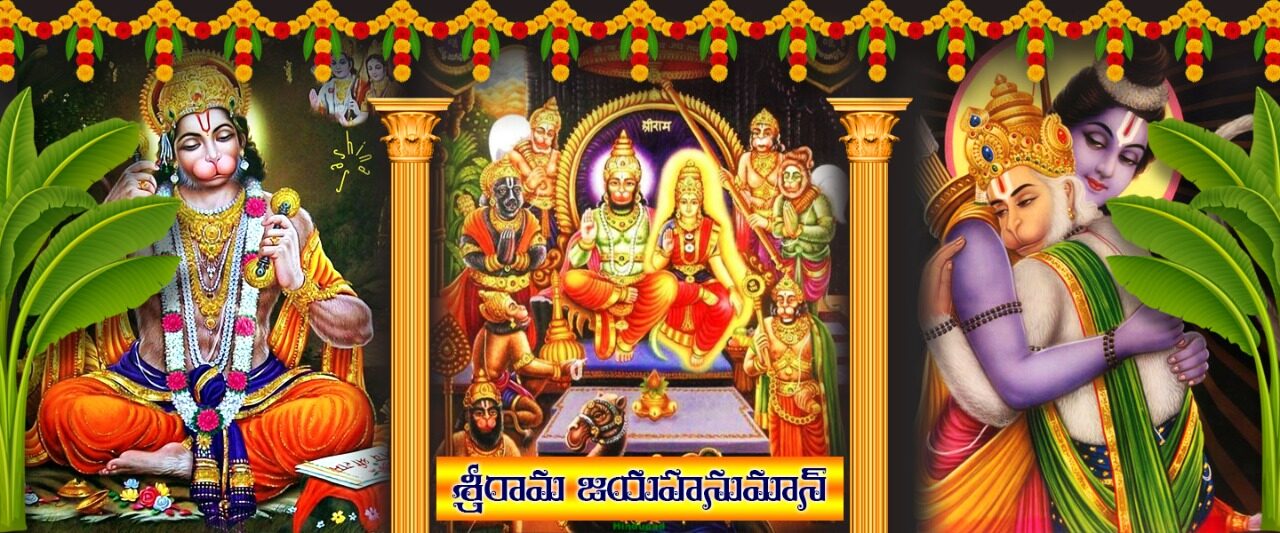

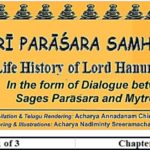



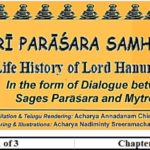
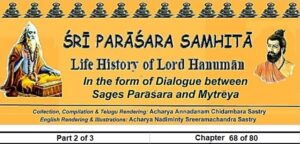
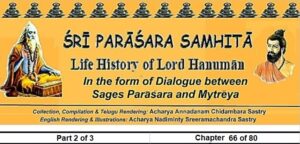
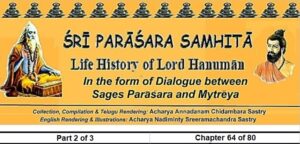
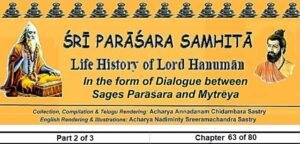
Be First to Comment